Bachmann 2-4-2 Columbia Tips
[ Home ] [ Up ] [ Previous
Page ] [ Next Page ]
 The Bachmann 2-4-2 Columbia is a small engine
modeled to look like an old western wood burning engine. There was
another version manufactured that was a coal burner. Actually, neither
follows a real prototype very closely. The closest prototype engine was
a cane field loco that was built by Baldwin and ran in Hawaii.
The Bachmann 2-4-2 Columbia is a small engine
modeled to look like an old western wood burning engine. There was
another version manufactured that was a coal burner. Actually, neither
follows a real prototype very closely. The closest prototype engine was
a cane field loco that was built by Baldwin and ran in Hawaii.
This engine should not be confused with the Bachmann Spectrum Line
2-4-2T which is a much newer and more capable engine.
The 2-4-2 Columbia type got its name because one of the first ones
manufactured was exhibited at the World's Columbian Exposition at
Chicago in 1893. The engine type was generally not very successful and
not many were built. The 4-4-0 American and 4-6-0 Ten Wheeler types
tracked better at speed due to their 4 wheel leading truck and the
2-6-0 Mogul type was generally bigger and provided better traction in
freight service due to more weight and six drivers. The Columbia was
just too small to take advantage of the larger firebox that the
trailing truck allowed. The real advantage of the trailing truck was
realized in the larger Atlantic, Pacific and Mikado class engines.
True to its prototype heritage, the model isn't very successful
either. Of all the large scale engines that I have come across, none
tracks or pulls more poorly that this model. It is my understanding
that this version of the engine is no longer in production.
The engine does have a kind of a "cute" look to it and since it does
actually run, it deserves the attention that it takes to make it
marginally useful.
Contents
Derailments
The engine, especially the leading truck, has a tendency to derail
often, especially over turnouts. There is really little that can be
done besides checking and setting the leading and trailing truck gauge.
There is not enough clearance above the truck to add much weight to the
trucks, but 1 oz of stick on HO type weights does help some.
Shimming the drivers also helps keep the frame in line and helps to
minimize derailments. This also works on the 4-6-0 Big Hauler. The
shimming method can be found in the Big Hauler Tips Page.
[ Top ]
Gearing
The gearing method used in the Columbia is similar to the early
model Big Haulers. However, the gearing is less likely to get mangled
simply because the engine pulls so poorly that little stress gets
applied to the gears. Two or at most three cars is about all this
little engine can handle even on light grades. On a 5% grade, one car
is about it.
When I first got my Columbia many many moons ago, it ran terrible.
It jerked badly and had awful gear noise. I finally got so tired of it
that I sent it back to Bachmann with $20 to get it repaired. Bachmann
was good to their warranty and when the engine came back, it had a new
bottom end. It ran very quietly and smoothly. The difference was
astounding. It still didn't pull worth a hoot, but at least it was
usable.
[ Top ]
Power Pickup
The Columbia suffers from flaky power pickup, just like its bigger
brother, the 4-6-0 Big Hauler, and for all the same reasons.
The spring loaded power contacts crap out, but not as badly as on
the Big Hauler because the engine draws less current and the contacts
don't heat as much. The fixes are the same as for the Big Hauler,
either remove and rebuild the contacts or substitute LGB contacts for
them.
The driver lateral play can allow the drivers to move away from the
contacts enough so that they no longer touch the backs of the drivers.
Shimming the drivers solves this problem.
The wheels get dirty easily and do require cleaning more often that
I would like.
The pony trucks are wired to pick up power but, as with the Big
Hauler, the bearings don't transmit power very well. Besides
lubricating the bearings with conductive oil, there is not much that
can be done with them.
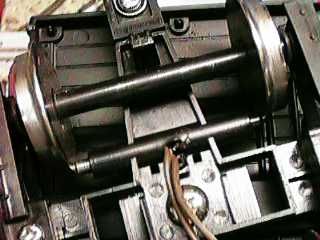 The tender
trucks on the Columbia have pockets molded in them that accept LGB
power pickups. By installing metal wheels and wiring power contacts to
the engine, a significant improvement in power pickup reliability can
be realized. However, this improvement comes at the cost of increased
drag which this little engine can ill afford.
The tender
trucks on the Columbia have pockets molded in them that accept LGB
power pickups. By installing metal wheels and wiring power contacts to
the engine, a significant improvement in power pickup reliability can
be realized. However, this improvement comes at the cost of increased
drag which this little engine can ill afford.
The tender trucks take small wheels. I used Gary Raymond 33"
wheelsets. Dean Lowe also makes wheels that will fit.
With the trucks disassembled, drill out the plastic wall between the
adjacent pockets with a drill a couple of sizes smaller than the
pockets. Then use the same drill to drill through to this new passage
from the outside. Solder small flexible wires to each contact and
thread the wires into the pocket and out the new center hole.
Reassemble the truck and wire the new contacts to the engine. The
trailing truck is a convenient place to connect to the engine by
soldering wires to the existing wheel bearings.
The Gary Raymond semi-finescale wheels that I had put on the tender
had been causing derailment problems all along. The smaller, more
visually attractive, flange was just not big enough to provide reliable
tracking. I installed a set of Aristo
C-16 tender wheels that I had taken off the C-16 during
investigation of a power pickup problem. These wheels have a typical
large scale (that is way out of scale) flange and they track MUCH
better. The power pickup seems to be good too.
[ Top ]
Sound
The sound system in the Columbia is identical to the Big Hauler
sound system. The Better Bachmann
Sound For About A Buck page describes modifying the sound in a Big
Hauler. All of the modifications described there are entirely
applicable to the Columbia. However, since the drivers on the Columbia
are much smaller than on the Big Hauler, making the 4 chuff
modification may make the engine chuff entirely too fast unless you
like to run fairly slowly.
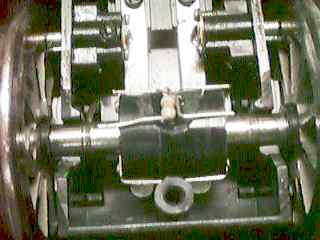 There is one
complication on the Columbia that doesn't exist on the Big Hauler. The
sound drum is so close to the front mounting post for the bottom cover
that the resistors won't fit without modifications to the drum. I cut
grooves into the drum with a motor tool to recess the resistors and
glued them on with ZapCA.
There is one
complication on the Columbia that doesn't exist on the Big Hauler. The
sound drum is so close to the front mounting post for the bottom cover
that the resistors won't fit without modifications to the drum. I cut
grooves into the drum with a motor tool to recess the resistors and
glued them on with ZapCA.
Like some Big Haulers, the wire that leads between the engine and
tender that connects the sound system gets stiff with age and will
often pull out if its socket. I just replace the wire with a piece of
very small zip cord. Disassembly of the connector can be a challenge,
but it can be done by using a sharp tool to depress the metal clips
that hold the contacts in the connector shell.
[ Top ]
Other Characteristics
Smoke. The Columbia is equipped with a smoke generator but it
cannot be turned off. I was not aware that it had smoke until I pulled
off the stack and looked. It had apparently burned out because it does
not work. The stack (on the wood burner at least) is too small to
accept an LGB smoke unit.
Front Coupler. The front coupler on the Columbia is just a
dummy unit. Even with a functioning coupler it would be fully useless
as the front overhang on curves is too great.
Pilot. The pilot on my wood burner hung too low and caught on
the track often. I've modified the pilot support rods to pull the pilot
up higher so that it will clear normal obstacles.
[ Top ]
A Newer Model?
I've seen reports that Bachmann is still producing an updated
version of the Columbia. From the reports on LSOL, the newer engine has
a completely redesigned gear train. The motor now sits vertically
instead of horizontally behind the rear axle. The reports also indicate
that the engine pulls better than mine and has a smoke unit.
Externally, the model appears to be similar. If you see one cheap, it
might be a deal.
[ Top ]
DCC Installation
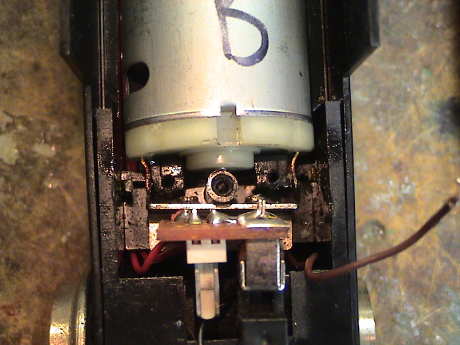 I have elected to convert the GIRR Mountain Division to DCC. This
means installing a DCC decoder in every loco. One of the things that
must be done in a DCC installation is to isolate the motor from all
other wiring. This is a photo of the motor once all the other wiring
has been removed. There is a metal strip down each side of the brick
that brings track power back from the front pony truck and the drivers.
It terminates on a small tab right next to each motor tab. The motor
tabs used to be soldered to these strips. There was also a pair of
wires leading to the rear pony truck and another pair leading up into
the boiler for the (defunct) smoke unit and the headlight. There is no
smoke switch in this loco, the smoke unit runs all the time which is
probably why it died.
I have elected to convert the GIRR Mountain Division to DCC. This
means installing a DCC decoder in every loco. One of the things that
must be done in a DCC installation is to isolate the motor from all
other wiring. This is a photo of the motor once all the other wiring
has been removed. There is a metal strip down each side of the brick
that brings track power back from the front pony truck and the drivers.
It terminates on a small tab right next to each motor tab. The motor
tabs used to be soldered to these strips. There was also a pair of
wires leading to the rear pony truck and another pair leading up into
the boiler for the (defunct) smoke unit and the headlight. There is no
smoke switch in this loco, the smoke unit runs all the time which is
probably why it died.
I have bent the motor tabs inward and the contact tabs outward to
provide clearance between them. The two wires that were soldered to the
tab on each side were later reconnected and insulated with shrink tube.
A new pair was soldered to the motor tabs and also insulated with
shrink tube. All of these connections are accessible from the top of
the brick.
There just wasn't room in the loco to install a DG583S decoder. The
boiler would have been marginally big enough, except it is nearly full
of cast iron and what space was left, I had filled with lead sometime
in the deep dark distant past. If the smoke unit was removed, the smoke
box would have been long enough but not quite wide enough. A NCE D08SR
might have fit in the smoke box, but I didn't have one handy as I had
just used the last one I had in a Lehmann Porter.
The only place left for the decoder was in the tender so I wired the
motor leads back to a connector to the tender.
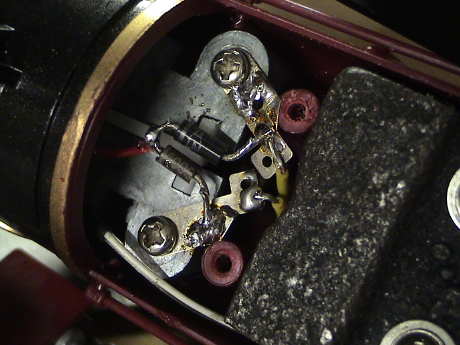 My
standard connector has only 3 conductors, two were for the motor and
one for the headlight white wire. However, there weren't enough pins
for the blue wire to power the headlight so I synthesized a blue wire
with half of a bridge rectifier in the form of two diodes soldered to
the tabs of the now dead smoke unit.
My
standard connector has only 3 conductors, two were for the motor and
one for the headlight white wire. However, there weren't enough pins
for the blue wire to power the headlight so I synthesized a blue wire
with half of a bridge rectifier in the form of two diodes soldered to
the tabs of the now dead smoke unit.
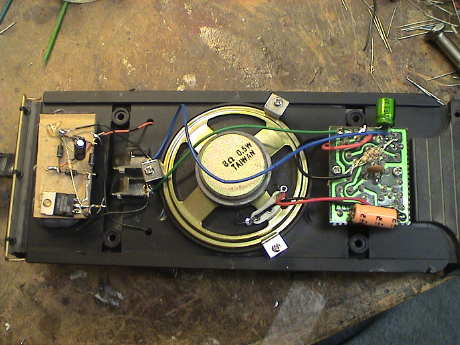 This
is what the tender looked like before I started. The circuit at the
left is a "battery eliminator" for the sound system. It runs from
analog track power to provide 9 volts. When the track power goes away,
so does the power to the sound system so that the chuff would not sit
there blowing continuously when the loco was stopped with the chuff
switch closed. This would not work with DCC because there is track
power all the time. I tried powering this circuit from the motor output
of the decoder, but there was just too much decoder noise getting
through the regulator. Instead, I used my more normal chuff cutoff
circuit as shown in Better Bachmann
Sound For About A Buck. However, in this installation it didn't
work quite right, I had to make it less sensitive by adding a 200 ohm
resistor between the base and emitter of the transistor.
This
is what the tender looked like before I started. The circuit at the
left is a "battery eliminator" for the sound system. It runs from
analog track power to provide 9 volts. When the track power goes away,
so does the power to the sound system so that the chuff would not sit
there blowing continuously when the loco was stopped with the chuff
switch closed. This would not work with DCC because there is track
power all the time. I tried powering this circuit from the motor output
of the decoder, but there was just too much decoder noise getting
through the regulator. Instead, I used my more normal chuff cutoff
circuit as shown in Better Bachmann
Sound For About A Buck. However, in this installation it didn't
work quite right, I had to make it less sensitive by adding a 200 ohm
resistor between the base and emitter of the transistor.
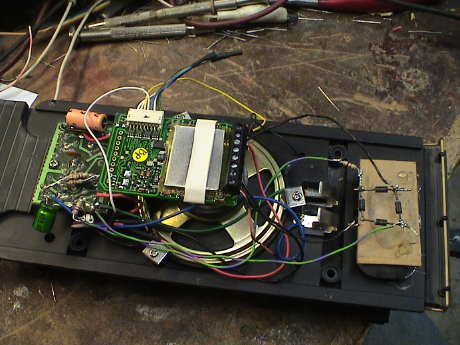 This
is the installation in the tender as completed. The little regulator
circuit has degenerated into a bridge rectifier. The transistor is
mounted next to the sound board. The decoder sits atop the speaker and
pokes up through the hole in the tender shell under the wood load. The
tender will again use a 9V battery to power the sound system but these
last for years.
This
is the installation in the tender as completed. The little regulator
circuit has degenerated into a bridge rectifier. The transistor is
mounted next to the sound board. The decoder sits atop the speaker and
pokes up through the hole in the tender shell under the wood load. The
tender will again use a 9V battery to power the sound system but these
last for years.
The Columbia runs quite well with DCC installed. It seems
uncharacteristically smooth and quiet.
[ Top ] [ Home ] [ Up ] [ Previous Page ] [ Next Page ]
This page has been accessed  times since May 3, 1998.
times since May 3, 1998.
©1998-2008 George Schreyer
Created May 3, 1998
Last Updated December 18, 2008
 The Bachmann 2-4-2 Columbia is a small engine
modeled to look like an old western wood burning engine. There was
another version manufactured that was a coal burner. Actually, neither
follows a real prototype very closely. The closest prototype engine was
a cane field loco that was built by Baldwin and ran in Hawaii.
The Bachmann 2-4-2 Columbia is a small engine
modeled to look like an old western wood burning engine. There was
another version manufactured that was a coal burner. Actually, neither
follows a real prototype very closely. The closest prototype engine was
a cane field loco that was built by Baldwin and ran in Hawaii. 18 Dec 08
18 Dec 08 1 Oct 08
1 Oct 08 The tender
trucks on the Columbia have pockets molded in them that accept LGB
power pickups. By installing metal wheels and wiring power contacts to
the engine, a significant improvement in power pickup reliability can
be realized. However, this improvement comes at the cost of increased
drag which this little engine can ill afford.
The tender
trucks on the Columbia have pockets molded in them that accept LGB
power pickups. By installing metal wheels and wiring power contacts to
the engine, a significant improvement in power pickup reliability can
be realized. However, this improvement comes at the cost of increased
drag which this little engine can ill afford. There is one
complication on the Columbia that doesn't exist on the Big Hauler. The
sound drum is so close to the front mounting post for the bottom cover
that the resistors won't fit without modifications to the drum. I cut
grooves into the drum with a motor tool to recess the resistors and
glued them on with ZapCA.
There is one
complication on the Columbia that doesn't exist on the Big Hauler. The
sound drum is so close to the front mounting post for the bottom cover
that the resistors won't fit without modifications to the drum. I cut
grooves into the drum with a motor tool to recess the resistors and
glued them on with ZapCA. I have elected to convert the GIRR Mountain Division to DCC. This
means installing a DCC decoder in every loco. One of the things that
must be done in a DCC installation is to isolate the motor from all
other wiring. This is a photo of the motor once all the other wiring
has been removed. There is a metal strip down each side of the brick
that brings track power back from the front pony truck and the drivers.
It terminates on a small tab right next to each motor tab. The motor
tabs used to be soldered to these strips. There was also a pair of
wires leading to the rear pony truck and another pair leading up into
the boiler for the (defunct) smoke unit and the headlight. There is no
smoke switch in this loco, the smoke unit runs all the time which is
probably why it died.
I have elected to convert the GIRR Mountain Division to DCC. This
means installing a DCC decoder in every loco. One of the things that
must be done in a DCC installation is to isolate the motor from all
other wiring. This is a photo of the motor once all the other wiring
has been removed. There is a metal strip down each side of the brick
that brings track power back from the front pony truck and the drivers.
It terminates on a small tab right next to each motor tab. The motor
tabs used to be soldered to these strips. There was also a pair of
wires leading to the rear pony truck and another pair leading up into
the boiler for the (defunct) smoke unit and the headlight. There is no
smoke switch in this loco, the smoke unit runs all the time which is
probably why it died. My
standard connector has only 3 conductors, two were for the motor and
one for the headlight white wire. However, there weren't enough pins
for the blue wire to power the headlight so I synthesized a blue wire
with half of a bridge rectifier in the form of two diodes soldered to
the tabs of the now dead smoke unit.
My
standard connector has only 3 conductors, two were for the motor and
one for the headlight white wire. However, there weren't enough pins
for the blue wire to power the headlight so I synthesized a blue wire
with half of a bridge rectifier in the form of two diodes soldered to
the tabs of the now dead smoke unit. This
is what the tender looked like before I started. The circuit at the
left is a "battery eliminator" for the sound system. It runs from
analog track power to provide 9 volts. When the track power goes away,
so does the power to the sound system so that the chuff would not sit
there blowing continuously when the loco was stopped with the chuff
switch closed. This would not work with DCC because there is track
power all the time. I tried powering this circuit from the motor output
of the decoder, but there was just too much decoder noise getting
through the regulator. Instead, I used my more normal chuff cutoff
circuit as shown in
This
is what the tender looked like before I started. The circuit at the
left is a "battery eliminator" for the sound system. It runs from
analog track power to provide 9 volts. When the track power goes away,
so does the power to the sound system so that the chuff would not sit
there blowing continuously when the loco was stopped with the chuff
switch closed. This would not work with DCC because there is track
power all the time. I tried powering this circuit from the motor output
of the decoder, but there was just too much decoder noise getting
through the regulator. Instead, I used my more normal chuff cutoff
circuit as shown in  This
is the installation in the tender as completed. The little regulator
circuit has degenerated into a bridge rectifier. The transistor is
mounted next to the sound board. The decoder sits atop the speaker and
pokes up through the hole in the tender shell under the wood load. The
tender will again use a 9V battery to power the sound system but these
last for years.
This
is the installation in the tender as completed. The little regulator
circuit has degenerated into a bridge rectifier. The transistor is
mounted next to the sound board. The decoder sits atop the speaker and
pokes up through the hole in the tender shell under the wood load. The
tender will again use a 9V battery to power the sound system but these
last for years.